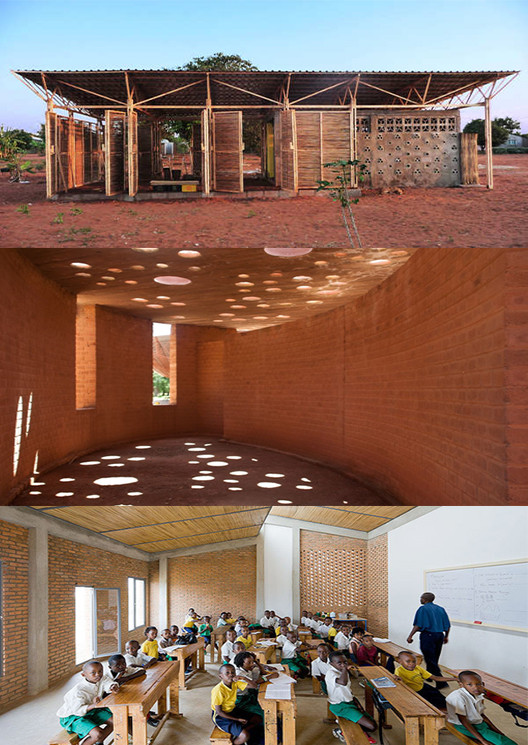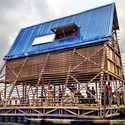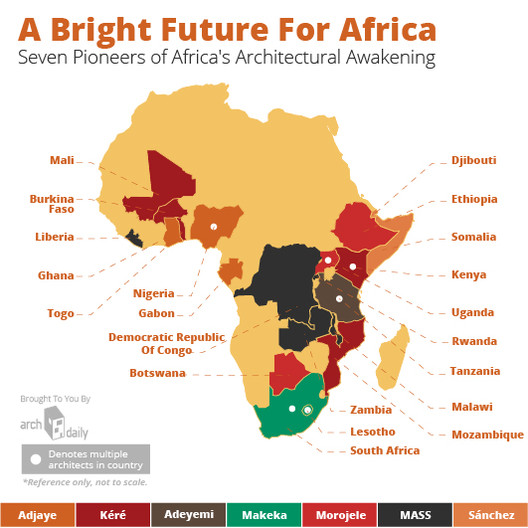In designing and building multiple successful public buildings in central Africa and around the world, MASS Design Group has employed and guided thousands of local craftsmen, curating the building process to inspire dignity. Now, they wish to help the African people obtain the skills necessary to guide the process themselves. At the United Nations Solutions Summit this Sunday Christian Benimana, a program director for the non-profit design studio, will present plans for what they are calling the “Bauhaus of Africa”: three “African Design Centers” to be built over the next 10 years in strategic locations throughout the continent. The design centers will house an education program tasked with training a new generation of African architects - a workforce certain to be indispensable as Africa enters a period of unprecedented urban growth.
MASS Design Group: The Latest Architecture and News
MASS Design Group to Propose “Bauhaus of Africa” at UN Summit
#LoFab: MASS Design Group's Campaign For Local Building
"If I get a contract, so does the entire neighborhood."
7 Architects Designing a Diverse Future in Africa

As the legacy of the Cold War fades and Western preeminence gradually becomes a thing of the past, population booms in Asia followed by the growth of a vast non-western middle class have seriously challenged the Western perception of the world. The East has become the focal point of the world’s development.
If East Asia is the present focal point of this development, the future indisputably lies in Africa. Long featuring in the Western consciousness only as a land of unending suffering, it is now a place of rapidly falling poverty, increasing investment, and young populations. It seems only fair that Africa’s rich cultures and growing population (predicted to reach 1.4 billion by 2025) finally take the stage, but it’s crucially important that Africa’s future development is done right. Subject to colonialism for centuries, development in the past was characterized by systems that were designed for the benefit of the colonists. Even recently, resource and energy heavy concrete buildings, clothes donations that damage native textile industries, and reforestation programs that plant water hungry and overly flammable trees have all been seen, leaving NGOs open to accusations of well-meaning ignorance.
Fortunately, a growth in native practices and a more sensible, sensitive approach from foreign organizations has led to the rise of architectural groups creating buildings which learn from and improve Africa. Combining local solutions with the most appropriate Western ideas, for the first time these new developments break down the perception of monolithic Africa and have begun engaging with individual cultures; using elements of non-local architecture when they improve a development rather than creating a pastiche of an imagined pan-African culture. The visions these groups articulate are by no means the same - sustainable rural development, high end luxury residences and dignified civic constructions all feature - but they have in common their argument for a bright future across Africa. We’ve collected seven pioneers of Africa’s architectural awakening - read on after the break for the full article and infographic.
Dear Martha: An Open Letter to the Pritzker Prize Committee

As the Pritzker Jury begins its deliberations for the 2015 Pritzker Prize, this is a critical time of year for shaping the landscape of architectural debate for the coming year and beyond. The following is an open letter to Martha Thorne, the Executive Director of the Pritzker Prize, from Conrad Newel, author of the popular blog Notes on Becoming a Famous Architect.
Dear Martha,
I have to hand it to you and all the people on the Pritzker committee, you guys are a very crafty bunch. Just when I thought I had you all figured out, you have now - even though only slightly - succeeded in confounding me.
From my 2011 analysis of the Pritzker, I figured that your potential pool of laureates was always a very predictable bunch. In fact anyone could look at my data and predict with reasonable certainty that the next laureate would most likely be an Asian or Caucasian male starchitect from Europe, The USA, or Japan. I further pointed out that none of your laureates have done much in the way of humanitarianism, despite the fact that the mission statement of the Pritzker also asks that the recipient should be making significant contributions to humanity. I maintained that this part of the mandate has been consistently overlooked.
Code of Context: The Uneasy Excitement of Global Practice


Global, the Winter 2014 issue of ArchitectureBoston magazine, out now, is an examination of the challenges and opportunities facing architects working abroad, from the Middle East to Africa to Asia. The topics explored in this issue include how to value resource-constrained approaches, honor local vernacular, and learn from the urbanization precedents set in other parts of the world. In this article, Jay Wickersham FAIA examines how in a globalized market, architecture firms can take steps to ensure that their designs act in the best interests of the foreign communities they affect.
The signs of architecture’s globalization are all around us. Foreign students flock to Boston to study architecture, prominent buildings are designed by foreign architects, American firms build practices around international projects. Globalization has allowed architects to work outside their own regions and cultures, at a scale and with a freedom of design they might never enjoy at home. But beneath the excitement and glamour of international practice, I sense an unease. Are we creating vital and original new architectures, or are we homogenizing cities and landscapes and obliterating regional differences? Are architects helping to strengthen and develop the economies of host communities, or are they acting as unwitting tools of inequality and repression?
Five Design Teams Re-Envision New York's Public Libraries

There are 207 branch libraries in the city of New York, each providing a number of services to city residents. From the simple lending of books to adult technical literacy classes, these institutions are as vital as they were before the advent of the internet, and their attendance numbers prove it. Between the years of 2002 and 2011, circulation in the city’s library systems increased by 59%. Library program attendance saw an increase of 40%. In spite of this, library funding was cut by 8% within this same timeframe, which has made it difficult to keep many of the system’s buildings in good repair. To spark interest and support from city leaders, The Architectural League, in collaboration with the Center for an Urban Future, instigated the design study Re-Envisioning New York's Branch Libraries.
Sponsored by the Charles H. Revson Foundation, the study is the effort of five design teams chosen by the League. These teams - including MASS Design Group and SITU STUDIO - were charged with proposing exciting new library designs that follow the League’s themes of “integrating libraries into the city’s housing and community development goals, reconfiguring libraries to meet community needs, and developing new ideas for expanding the impact of branch libraries.” The teams presented their work at a January 4th symposium. See each of the proposals, as well as video footage of that symposium, after the break.
Kimmelman on MASS Design Group's Open-Air Clinics in Haiti

“Architecture and health are inseparable,” says Haitian doctor and founder of Gheskio in Michael Kimmelman’s latest New York Times piece In Haiti, Battling Disease With Open-Air Clinics. Recounting the devastating images of medical dysfunction that have circulated the internet since the Ebola epidemic, Kimmelman presents MASS Design Group’s nearly complete Port-au-Prince health clinics as a potential model for healthcare architecture worldwide. Combating cholera and tuberculosis with a modest, practical layout and open-air design, the new clinics will serve one of the city’s largest slums. Learn why Kimmelman declares them “handsome” and believes they will help eradicate disease in Haiti, here.
TED Talk: How MASS Design Group Gave the Word "Architecture" a Meaning in Rwanda
In one of the eight talks that make up the TED Prize-winning City2.0, MASS Design Group Co-founder and Chief Operating Officer Alan Ricks explains how MASS designed and built the Butaro Hospital in Rwanda, in 2008 when "there wasn't even a word for 'architect'" in Kinyarwanda, the national language. Now thanks in part to their work, and the commitment of the many MASS Design Fellows in the area, Rwanda has a more formalized market for architectural services and even a new architecture program at Kigali Institute of Science and Technology.
MASS Design Group's Latest Video: Design That Heals
In their sixth Beyond the Building video, “Design That Heals,” MASS Design Group explores how architects can improve the lives and health of people everywhere. The video reveals how the work of MASS operates on various scales from everything to designing better furniture to influencing national policies. Their approach to humanitarian architecture begins by empowering the local community to take ownership of new projects, and in turn, bring about significant improvements in the quality of life in places that have previously been overlooked.
For example, talking about MASS Design Group's Butaro Hospital, Rwanda's Minister for Health Dr. Agnes Binagwaho says: "There's this idea of equity to put a hospital, state of the art, in the middle of nowhere. It was not nowhere for everybody, because there are 300,000 people living there." Watch the video above and get involved in the conversation on how architecture can go #beyondthebuilding.
MASS Design Group's Latest "Beyond the Building" Video: Building Better Builders
In their fifth Beyond the Building video, "Building Better Builders," MASS Design Group goes behind the scenes of their projects in Haiti to speak with local architects and metalworkers and show how incorporating local talent can engage the local community to develop innovative solutions.
Three Projects That Transform Low-Tech Materials Into Innovative Design

The following article is presented by Materials, ArchDaily's new US product catalog.
How many times in the last year have you heard 3d printing mentioned? What about double-skinned curtain walls or “smart” buildings? High-tech materials almost always seem to dominate the conversation - at least in architectural circles. But using the latest invention in material technology usually does not make a building “innovative.” More often than not, it just makes it expensive and flashy.
Low-tech materials like lumber, stone and brick, on the other hand, are often overlooked, even though the use of local and locally produced materials offers the lowest possible carbon footprint. And while these common materials may seem boring, with a bit of imagination and technical skill, an architect can transform these materials into something fresh. With that in mind, check out three truly innovative projects which use low-tech materials in different and exciting ways.
VIDEO: Can Architecture Foster Dignity?
Believing the lack of dignity is a motivator of crime, MASS Design Group has dedicated their fourth Beyond the Building video series to the notion that architecture has the capacity to build peace. Focusing on how the building process can foster dignity, as well as economic and social justice, MASS encourages architects to ask themselves: “How can we use architecture to contribute to peace, conflict resolution, instill dignity, and promote justice?” Watch the video above and share your thoughts on how architecture can go #beyondthebuilding.
VIDEO: Extreme Sustainability in the Congo
MASS has just released the third video in their Beyond the Building series, which examines how architecture and design can positively impact our world, beyond buildings (check out the first video here and the second here). The latest - "Ilima: Beyond Sustainability" - explores MASS's collaboration with the African Wildlife Foundation as well as local masons to build a primary school in the rural Congolese village of Ilima, where, due to its remote location, practically all materials must be sourced locally.
VIDEO: The Story of Kankwazi, MASS's First Female Master Mason
In honor of International Women's Day, MASS Design Group has released the latest in their video series “Beyond the Building,” a visual exploration of the ways architecture impacts lives around the world (see the first in the series here).
Autodesk Launches Foundation Aimed to Solve "Epic Design Challenges"

Autodesk has launched the Autodesk Foundation, an organization which will "invest in and support the most impactful nonprofit organizations using the power of design to help solve epic challenges." In an effort to aid those tackling global issues such as "climate change, access to water, and healthcare," the foundation will provide select design-oriented grantees with software, training and financial support.
Video: MASS Design Group 'Beyond The Building'
MASS Design Group, the award-winning design group behind the Butaro Hospital and Umubano Primary School in Rwanda as well as other public-interest projects in Haiti, have launched a video series on a great topic that really resonates with us. "Beyond the Building" will look at the ways in which architecture, beyond buildings, impacts lives around the world, giving dignity back to the users. Check out the awesome video above (the first of the series) and join the conversation on Twitter by using the hashtag #beyondthebuilding.
Who Will We Consider Today's Greatest Design Innovators, Tomorrow?

Often, it is only with hindsight that we can truly understand our world; looking back at how important certain events and people proved to be is much easier than predicting their importance at the time. Still, guessing who will be remembered in posterity is a fun game, so The Atlantic asked various industry leaders "Who Will Tomorrow's Historians Consider Today's Greatest Inventors?" The answers span across business, science, technology and design, and among the 9 nominations there are a few names that architects and urban designers may find interesting. Read on after the break to find out just who they are.
MASS Design Group Joins African Education Initiative

Together with the African Wildlife Foundation (AWF), MASS Design Group is helping to build 15 conservation primary schools over the next 10 years in African landscapes, home to some of world's most important wildlife populations, including elephants, rhinos, great apes, and lions. They will design non-traditional educational campuses for primary school children that offer lessons and other services extending beyond the classroom walls.














